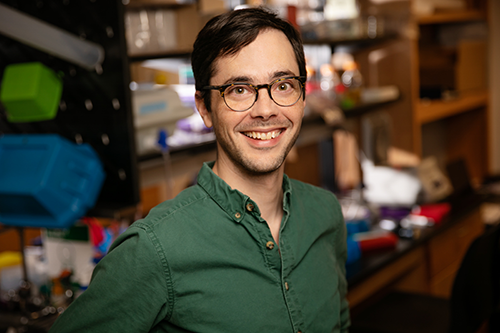

(Photo by L. Brian Stauffer.)
Editor’s note: The novel coronavirus that first broke out in Wuhan, China in late 2019 has now spread to almost 70 countries, and the first case of possible community spread has been reported in the United States. The Centers for Disease Control and Prevention is monitoring the public health risks from the coronavirus, recently named SARS-CoV2, and the respiratory disease it causes, COVID-19. University of Illinois at Urbana-Champaign microbiology professor Christopher Brooke, an expert in viruses and how they spread, discussed with News Bureau biomedical sciences editor Liz Ahlberg Touchstone what makes the novel coronavirus a public health concern.
The novel coronavirus isn’t the only type of coronavirus. What are examples of others? What are the symptoms of this group of viruses?
All coronaviruses known to infect humans primarily infect the respiratory tract, and can lead to a wide range of symptoms and infection outcomes, ranging from coldlike symptoms to severe respiratory distress and death.
There are a number of very common human coronaviruses that are associated with the common cold and have been circulating in the human population for years. Most people have been infected with one or more of these viruses.
People may have heard of either SARS, which caused a global outbreak in 2003, or MERS, which emerged into humans in the Middle East in 2012. These viruses gained a lot of media attention because they were associated with high rates of severe disease and mortality and were able to spread between countries, though the number of infections with either of these viruses was relatively low. Both of these viruses were animal viruses that crossed over into humans.
What do we know about how the virus spreads? How contagious is it?
The virus can spread via the respiratory route: inhaling virus exhaled or coughed by infected people, as well as potentially by contact with contaminated surfaces. It is still hard to accurately estimate how precisely how contagious the virus is at this point, but it appears to be fairly contagious – potentially more contagious than seasonal flu.
What makes the virus a public health concern in the United States?
Epidemiologists agree that widespread community spread of the virus in the U.S. is highly likely, and local outbreaks are already underway in areas of Washington, New York, and California. This is a concern because rates of severe disease and mortality are fairly high, at least among people over the age of 50.
I see reports of more deaths every day. How deadly is it?
This virus is roughly 10 times more lethal than the seasonal influenza virus. Recent estimates suggest that roughly 1 percent of infections are lethal. This number may seem small but when you are talking about half or more of the country getting infected over the next year, you are talking about a lot of people. Within that 1 percent, mortality rates are highly age-dependent and are much higher for older people and people with other underlying health conditions.
Importantly, large numbers of cases can overwhelm the health care system, resulting in increased mortality rates from COVID-19, as well as from other conditions due to lack of adequate available care.
What can people do to prevent contracting COVID-19?
The most critical thing that people can do practice social distancing by limiting their contact with other people, limiting the extent to which the visit places with crowds like stores or restaurants. This has been shown to be highly effective in limiting viral spread through communities, and is something that we can all easily do. Also, self-quarantining yourself if you feel any flu- or cold-like symptoms to help minimize spread within the community.
Transmission routes for coronavirus and influenza are similar, so the same prevention strategies apply to both. Wash your hands regularly with soap and water, as well as hand sanitizer; avoid touching your eyes, nose and mouth as much as possible; and keep your distance from anyone coughing or sneezing. The World Health Organization has more recommendations on its website.
Are there treatments in development?
The National Institutes of Health and other government agencies are aggressively pushing the development of vaccines and anti-viral drugs that may help control SARS-CoV2. This is built upon basic research done by teams around the world to develop other coronavirus vaccines and therapeutics before this outbreak.
Unfortunately, these things take time, and there is not likely to be a licensed vaccine for 12 months or more. There is a promising antiviral drug that works well against related coronaviruses in animals, called Remdesivir, that currently is being tested in human COVID-19 patients. This is also not likely to be available in significant amounts any time soon.
Again, the most effective tool at our disposal right now is having people adopt the social distancing practices detailed above.
Editor's note: For the latest information about how campus is responding to coronavirus, visit the campus COVID-19 website.


